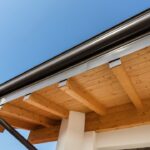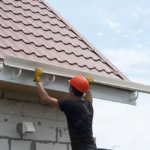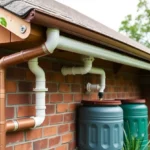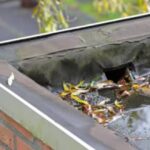When considering the installation of a flat roof, one of the primary questions on every potential homeowner’s mind is, how long does a flat roof last? Understanding the lifespan of a flat roof is vital to making informed decisions about your homes roofing needs. This article provides a thorough examination of flat roofs, focusing on longevity and associated factors, giving you the best insights on maintaining your roof.

Introduction to Flat Roofing Technology
Flat roofs have become a popular choice in both residential and commercial architecture due to their modern aesthetics and cost-effective nature. Unlike traditional pitched roofs, flat roofs offer a sleek design that can efficiently utilize space.
A flat roof typically complements buildings characterized by minimalist designs. Additionally, it often offers versatile uses, such as creating a deck or a green roof, enhancing the building’s functionality.
Flat Roof Lifespan: A Key Consideration
The lifespan of a flat roof is influenced by several factors, including the materials used, weather conditions, installation quality, and maintenance practices. Generally, flat roofs last between 10 to 25 years. However, this can vary widely based on specific conditions.
Types of Flat Roofing Materials and Their Longevity
1. Single-Ply Membranes: Commonly used materials include TPO (Thermoplastic Olefin) and EPDM (Ethylene Propylene Diene Terpolymer). TPO can last around 15 to 20 years, while EPDM may extend up to 25 years.
2. Modified Bitumen: Typically lasts between 10 to 20 years and is known for its durability and ease of repair.
3. Built-Up Roof (BUR): Known for its multiple layers, BUR can provide a lifespan of 15 to 30 years.
Factors Affecting Flat Roof Longevity
Understanding the factors affecting the lifespan of a flat roof is crucial for maximizing its longevity:
Quality of Materials
The type and quality of materials used can significantly dictate a flat roof’s durability. Opting for high-quality materials ensures better performance and longer life.
Installation Practices
Professional installation is critical. Improper installation can lead to leaks and premature wear. Therefore, employing a qualified contractor is essential in ensuring the roof’s longevity.
Climate and Weather Conditions
Flat roofs are more susceptible to weather-induced damages. In areas with extreme temperatures or frequent storms, routine inspections and maintenance become even more important.
Regular Maintenance
Routine maintenance is vital for a long-lasting flat roof. This includes regular inspections, cleaning debris, and repairing minor damages immediately to prevent them from escalating.
The Role of New Technologies in Roof Longevity
Advancements in roofing technology have introduced better materials and methods, enhancing the lifespan and efficiency of modern-day flat roofs. From improved insulation techniques to advanced weatherproof coatings, technology continues to play a crucial role in extending the life of flat roofs.
Cost vs Lifespan Analysis
While initial costs can vary depending on the material and technology used, its important to focus on cost-efficiency over time. A well-structured analysis of initial costs against expected lifespan can guide a homeowner in making financially sound decisions.
Materials like EPDM may present higher upfront costs but offer greater durability, thus proving economical over time. For an in-depth cost guide, explore this external source.
Benefits of Flat Roof Designs
Flat roofs offer tremendous advantages in terms of design and usability. They can transform spaces into functional areas or enhance the energy efficiency of a building.
Maximizing Roof Space
The flat design allows for the creation of extra usable space. This can be an attractive feature for eco-conscious homeowners interested in rooftop gardens or solar panel installations.
Energy Efficiency
Flat roofs can enhance the energy efficiency of buildings by offering optimal support for insulation materials. This ultimately leads to better thermal regulation and reduced energy costs.
Choosing the Right Flat Roof for Your Home
Selecting the appropriate flat roof involves considering several factors like climate, budget, and architectural style. It also includes deciding between different material options to suit customization needs.
Consulting with Professionals
To ensure longevity and efficacy, consult with experienced roofing professionals who can offer insights into the best materials and practices suitable for your environmental context and personal preferences.
Ensuring Modern Compliance
When planning a new roof installation or replacement, you should consider necessary permits and compliance with local regulations. More information on this can be found in this internal link.
FAQs About Flat Roofs
1. How often should a flat roof be inspected?
It’s recommended that homeowners inspect their flat roofs at least twice a year and after any significant storm or extreme weather event.
2. Is it possible to install a flat roof over an existing one?
Yes, it is feasible but dependent on the existing roof’s condition and structural capacity. Consulting with a professional is advised for an accurate assessment.
3. What are the signs that a flat roof needs replacement?
Signs may include persistent leaks, large cracks or blisters, and sagging areas. If you notice any of these, consulting a professional for an assessment is crucial.

Final Thoughts
Flat roofs bring several benefits, from aesthetic appeal to functional space. While the lifespan varies, understanding the key factors influencing longevity allows homeowners to make informed choices. Emphasizing quality materials, proper installation, and regular maintenance can significantly extend the life of your roof.
For more tips on roofing maintenance and repair, you can visit our internal link for detailed guidance.
This article contains affiliate links. We may earn a commission at no extra cost to you.







